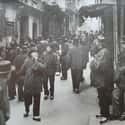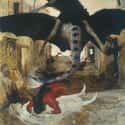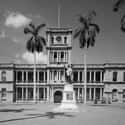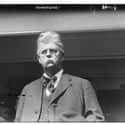-
(#5) Racism Was Undoubtedly A Factor In The Plague's Outbreak
The plague itself was a problem, but anti-immigrant sentiment and racism against Chinese people exacerbated the issue. Around this same time, the Chinese Exclusion Act, which prevented Chinese people who were not merchants from immigrating to the US, was extended. Rampant, unfounded anti-Chinese sentiment promoted racist policy, which in turn validated racist viewpoints because of state-sanctioned rules.
In the initial quarantine, white people in Chinatown were told to leave while Chinese residents were forced to stay. Miasma theory, which posited the disease was spread via contact with contaminated air, was blamed for the plague in Chinatown.
Rather than the poor sanitation being a symptom of the area's poverty, it was instead said to be evidence that the Chinese people themselves were the problem. Some went so far as to claim that a rice-based diet made them susceptible to the plague.
-
(#4) Rats From China Probably Carried The Plague To America On Ships
In the late 1800s and early 1900s, scientists and medical professionals weren't yet sure what caused the plague. The miasma theory, which suggested the disease was spread through "bad air," was popular, as were suggestions that the plague might travel through contaminated food or open wounds. The bubonic plague is actually transmitted via flea bite, with the carrier fleas often living on rats.
China was dealing with a plague outbreak of its own in the mid-late 1850s, which soon made its way to Hong Kong. Since Chinese immigrants and imports commonly made the journey to San Francisco, it was only a matter of time before the plague reached American soil.
-
(#1) The San Francisco Plague Was The First Major Plague Outbreak In The Continental US
Though the San Francisco plague was hardly the first major illness that residents of the continental US had to address, it was the first major outbreak of the plague. The illness — named the Black Plague or the Black Death when it ravaged Europe in the 1300s and caused some 50 million deaths — made a comeback in the 1800s, seriously affecting China and much of east Asia.
Because of global trade and increasing numbers of people emigrating and immigrating worldwide, it was only a matter of time before epidemics began to spread. However, people did not yet understand exactly how the disease was transmitted — many believed it spread through open wounds, food, or the "miasma" theory, which claimed that diseases like the plague spread through "bad air." Because of these conflicting, erroneous theories, the world wasn't prepared to respond to a wide-scale epidemic.
-
(#13) Honolulu's Chinatown Burned To The Ground When Authorities Attempted To Eradicate The Plague
The plague resurfaced in China on the backs of rats in the 1850s and wound up in Hong Kong. Chinese immigrants and imports often passed this way en route to San Franciso via port stopovers in Hawaii. Following one ship's stop in Hawaii in 1899, a case of the plague broke out in the Honolulu Chinatown, spreading quickly to four more people. In an attempt to contain the plague and eradicate the conditions fostering its rapid spread, The Hawaii Board of Health isolated the victims and quarantined 14 blocks of the area complete with military guards. According to historical record, "To clear contaminated areas, the Board set 41 controlled fires, cleaned and disinfected buildings, burned garbage, filled old cesspools and dug new ones."
However, when this failed to quell the problem and new cases of the plague arose, the Board set another fire which quickly spun out of control and resulted in all of Honolulu's Chinatown burning to the ground. The problematic ships nonetheless continued to San Francisco where, because people on the ships did not show plague symptoms, they were allowed to dock. Along with humans also disembarked infected rats, carrying the disease straight into the port city.
-
(#6) San Francisco's Governor Denied The Outbreak Out Of Fear It Would Hurt The City's Reputation
One of the biggest stumbling blocks to stopping the plague's initial four-year hold on San Francisco was the city government. The governor, Henry Gage, actively denied the city had a problem, fearing it would hurt tourism and trade. Worse, he didn't just deny the problem — he actively thwarted efforts to stop it. Gage claimed funds were being diverted to stop a plague that didn't exist. He also suggested Dr. Joseph J. Kinyoun, who led the quarantine effort, had fabricated or caused the plague himself by injecting Chinese residents with the disease.
Though there was little help available for victims, Gage's denial — as well as his active attempts to stoke tension between Kinyoun's efforts and the Chinese people whose civil rights were being violated — ensured the plague continued to ravage the city's ostracized citizens.
-
(#12) 119 People Died In The First Outbreak
119 people died during the San Francisco plague outbreak, many of them in the concentrated, quarantined region of Chinatown. Without access to health professionals and pest control, infected victims spread the plague inadvertently but rapidly. Although it's certainly a deadly disease, the city's failure to isolate the actual cause and treat infected people ensured its spread and ability to affect more people.
Though it's not the absolute deadliest outbreak in US history — the introduction of smallpox by European settlers killed almost all indigenous people in what is now North America, for example — the San Francisco plague is one that could have been prevented or had its harm minimized if those in authority had taken action.
Instead, it was allowed to fester in the city's most impoverished communities, sowing further anti-Chinese sentiment.
New Random Displays Display All By Ranking
About This Tool
The bubonic plague is one of the most deadly disasters in human history. From the 14th century until the early 19th century, the bubonic plague ravaged Europe and killed about a quarter of the population. In the early 20th century, the disease spread to San Francisco, although the US government attached great importance to the infectious disease, the plague in San Francisco was more lethal than it should have been.
The doctors fabricated that the disease would only appear in Asians and that whites would not be infected. Finally, the plague spread to all of San Francisco. The U.S. government still refused to recognize the outbreak of the plague. The random tool introduced 13 details about the outbreak of the bubonic plague in San Francisco in the 1900s.
Our data comes from Ranker, If you want to participate in the ranking of items displayed on this page, please click here.
















